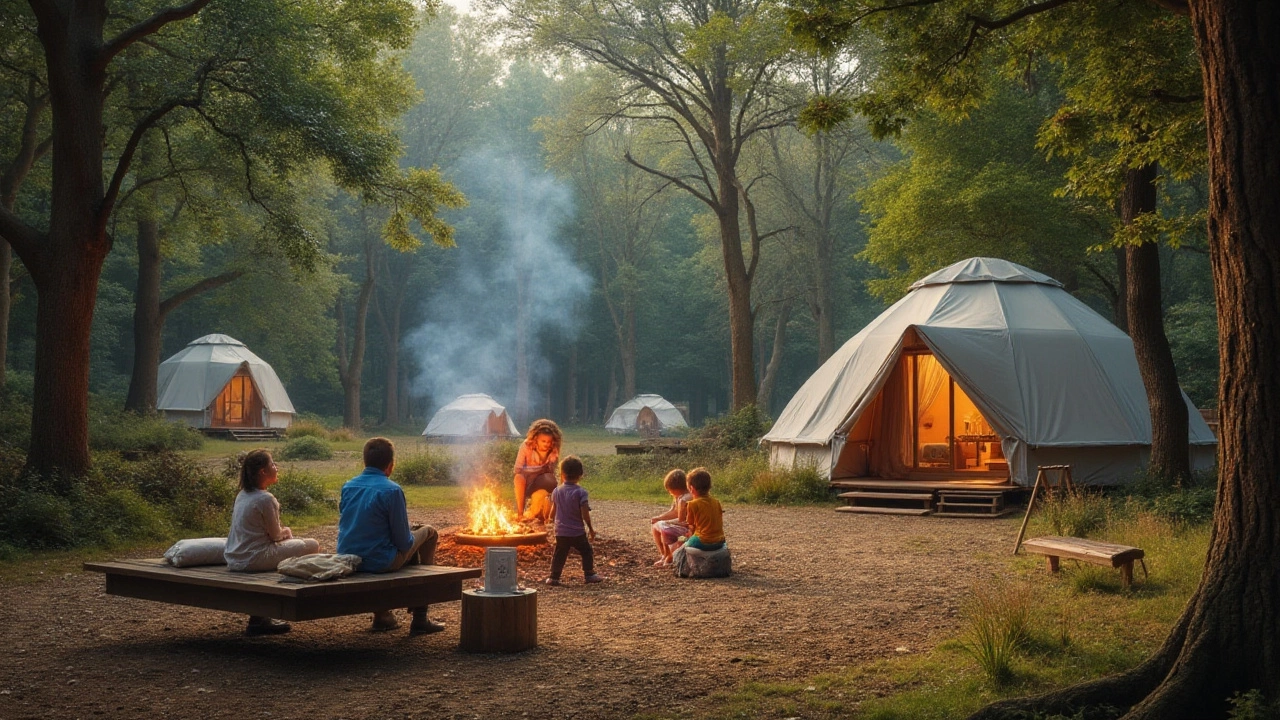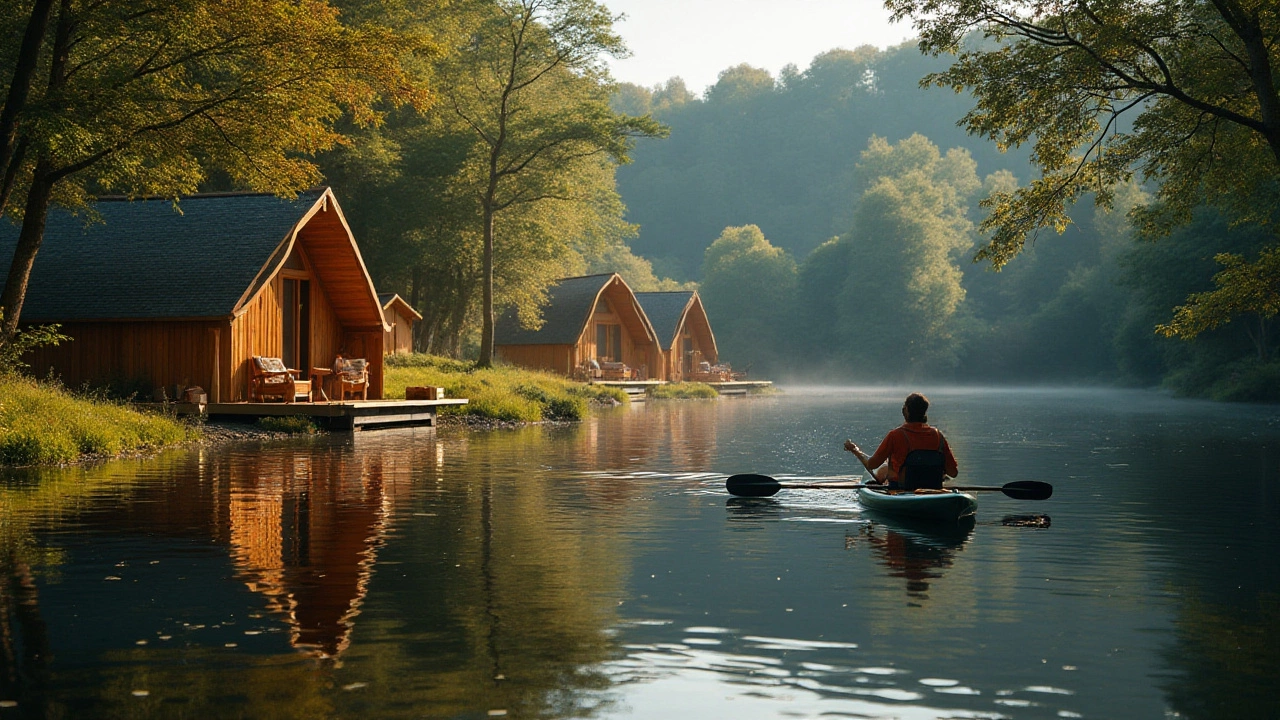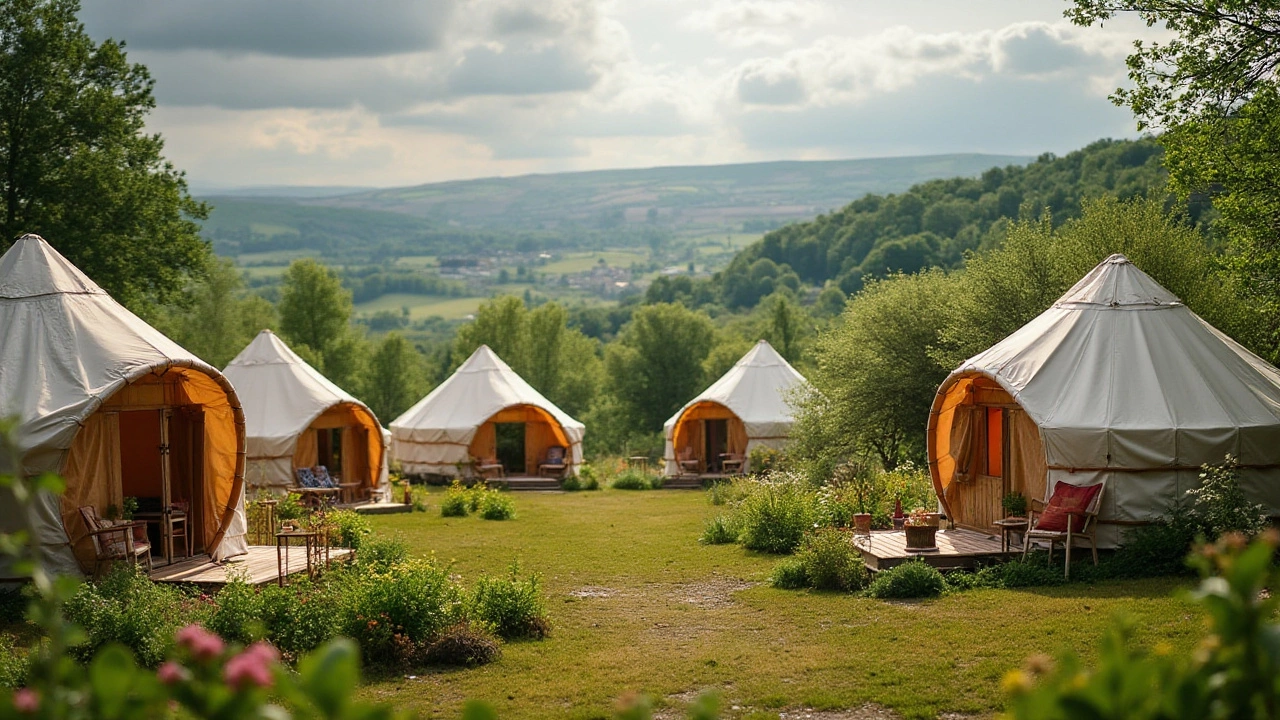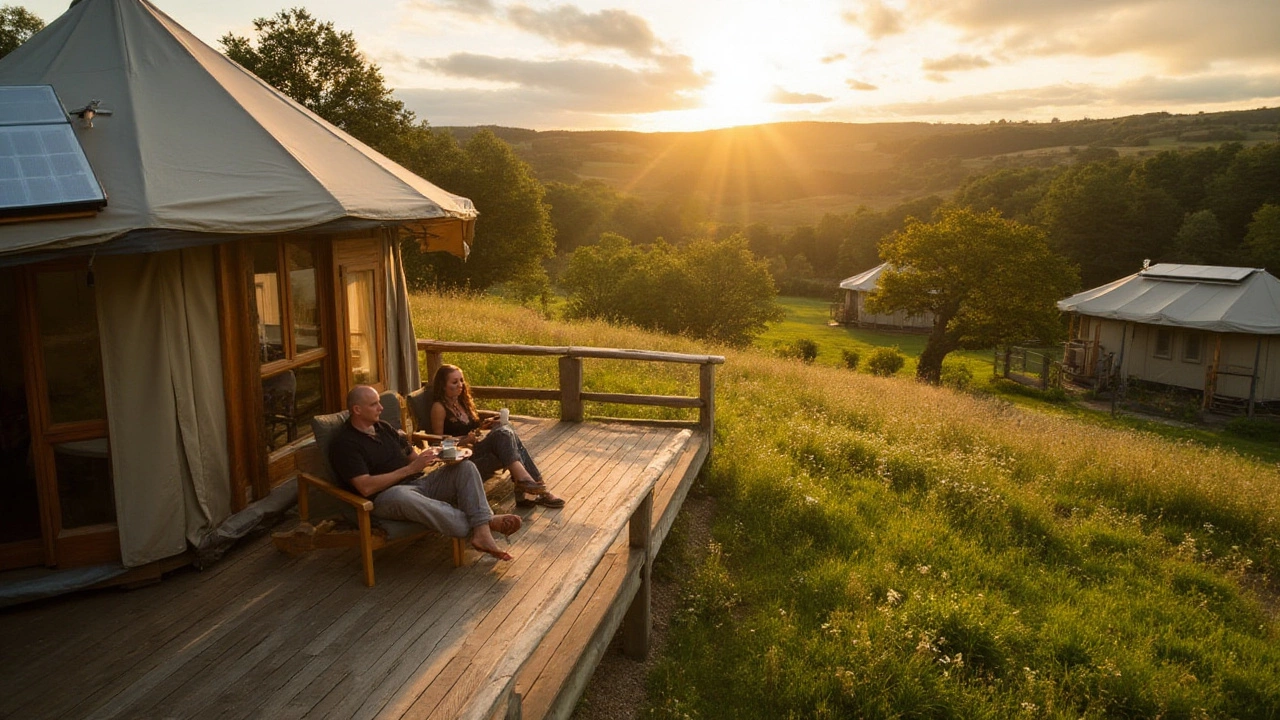Eco-Friendly Glamping: The Green Revolution in Outdoor Living
30 Jan, 2025Imagine a holiday where you blend the thrill of camping with all the comforts of a boutique hotel, all while treading lightly on the Earth. That's the heart of glamping, an evolving trend that is rewriting the rules of outdoor vacations. It's not just about luxury and style; it's about embracing a way of travel that respects the natural world.
These days, more glamping sites are turning towards sustainability by using solar power, sourcing materials responsibly, and even participating in local conservation efforts. Travelers are becoming more conscious of their choices, and glamping provides a perfect balance between comfort and eco-consciousness. Dive into a world where getting close to nature doesn't mean leaving a large footprint.
- The Basics of Eco-Friendly Glamping
- Sustainable Materials and Practices in Glamping
- How Glamping Reduces Environmental Impact
- Tips for Choosing Eco-Friendly Glamping Sites
The Basics of Eco-Friendly Glamping
Glamping, short for 'glamorous camping', has captured the imagination of travelers who crave a connection to nature without sacrificing comfort. The popularity of glamping has grown substantially because it marries luxury with the great outdoors, creating a unique experience where eco-consciousness is at the heart of the adventure. As our planet faces increasing environmental challenges, choosing an eco-friendly glamping destination becomes more important than ever. These sites are characterized by their commitment to using sustainable materials, conserving energy and water, and preserving the natural landscape. For instance, many use solar panels to harvest energy and implement rainwater harvesting systems. The push for sustainability in glamping also extends to architecture, with accommodations such as yurts, treehouses, and safari tents designed to have minimal environmental impact.
Glamping site operators often ensure that

Sustainable Materials and Practices in Glamping
Glamping's sustainable revolution stems from materials that harmonize luxury with eco-friendliness. Many glamping accommodations utilize locally sourced and renewable materials like bamboo, recycled wood, and canvas. These resources not only reduce transport emissions but also support local economies. Bamboo, for instance, is a favorite due to its incredible strength and rapid growth rate, making it an ideal structural component for tents and furniture. Canvas creates a durable, breathable barrier against the elements while offering a classic aesthetic. Sourcing materials locally minimizes ecological footprint, aligning with the values of eco-friendly glamping.
Beyond materials, glamping sites implement practices that actively preserve their environment. Rainwater harvesting systems collect and store water, ensuring that guests have a steady supply without straining local resources. Many sites incorporate solar panels, harnessing renewable energy to power essential amenities from lighting to heating. This shift not only reduces carbon emissions but also showcases a commitment to sustainable tourism. These energy-efficient innovations make the glamping experience comfortable yet conscious of its impact on nature.
Implementing Green Technologies
The integration of modern green technology is pivotal in sustainable glamping. Advanced waste management systems are becoming the norm. Composting toilets and on-site waste treatment facilities reduce reliance on traditional sewage systems, turning waste into a resource by converting it into usable compost. Such innovations lessen the environmental strain, proving that glamping can gracefully coexist with nature's prairies, forests, and rivers. An essential aspect is the public awareness on conserving energy and water while enjoying these eco-friendly retreats.
"Incorporating sustainable technology into glamping is not merely a trend; it's a responsibility we must all embrace," says eco-tourism expert Lara Greene.
Some glamping sites push boundaries by engaging in ecological projects, such as habitat restoration and native species planting. These initiatives not only enhance the guest experience but contribute positively to the flora and fauna that share the same space. Participating in such activities provides a unique educational experience, fostering a deeper appreciation for conservation. These efforts ensure that nature's narrative is at the forefront of the glamping journey, a testament to the power of sustainable tourism.
Challenges and Innovations
Despite the promising strides, integrating sustainable practices poses its challenges. Initial costs can be high, and local regulations may vary, affecting how eco-friendly measures can be implemented. However, the industry's ethos inspires creative solutions, encouraging collaboration with environmental engineers and designers. The result is an evolving portfolio of inventive structures and systems that set new standards for the travel industry. These innovations address challenges head-on, ensuring that sustainable travel remains accessible and delightful.
For those new to glamping, choosing sites that highlight these practices can significantly enhance their stay. Seek locations advertised as eco-friendly, inquire about their sustainability efforts, or browse websites that list certified green accommodations. Engaging with host communities can provide insights into their operations, offering an authentic glimpse into the world of green accommodations. Such participation reflects a shared commitment to preserving the natural world, ensuring that future generations can enjoy the beauty we often take for granted.

How Glamping Reduces Environmental Impact
Glamping has emerged as a pioneering movement within the realm of eco-tourism, driven by both travelers' desires for comfort and the necessity for sustainable practices. Unlike more traditional camping, which may inadvertently harm fragile ecosystems through disturbances like improper waste disposal or excessive foot traffic, glamping often incorporates advanced, environmentally conscious strategies designed to lessen its ecological footprint. Interestingly enough, a significant component that sets glamping apart is its unique blend of sustainability and luxury. By employing renewable energy, sourcing local materials, and integrating green technologies, glamping sites are paving the way toward more sustainable tourism methods.
One of the primary ways that glamping minimizes environmental impacts is through the use of eco-friendly infrastructures. Many glamping accommodations are made from sustainable or recycled materials. For instance, yurts, treehouses, and safari tents can be assembled using minimal resources and often without the need for heavy construction equipment, causing less disruption to their natural surroundings. These structures are designed to be temporary or semi-permanent, allowing them to be removed or relocated without leaving scars on the land. Moreover, these sites often prioritize low-energy consumption by implementing solar panels, LED lighting, and energy-efficient appliances.
"Glamping is not just a luxury getaway, it's a commitment to preserve our natural world," notes sustainability expert Dr. Rachel Simmons. "By choosing glamping, you're investing in the protection of the environment while still enjoying all the comforts of home."
Waste management is another crucial area where glamping significantly reduces its environmental impact. Many sites promote waste segregation and recycling as essential practices. Compostable toilets, greywater systems, and rainwater harvesting are increasingly being incorporated into their operations, ensuring that water consumption is kept minimal while also reducing pollution. Furthermore, embracing local resources not only supports regional economies but also reduces the carbon footprint associated with transporting materials over long distances.
Moreover, the location of many glamping sites plays a pivotal role in conservation. By developing these sites outside of high-risk ecological zones, the fragile habitats are preserved. Many glamping sites are created with the mission to restore and protect the surrounding nature. As a tourist, you help support these conservation efforts just by staying in an eco-friendly glamping retreat. Some innovative sites even contribute part of their profits towards local environmental projects, bridging the gap between tourism and conservation in a meaningful way.
Ultimately, glamping offers an enlightening perspective on how sustainable travel can effectively coexist with modern-day luxuries. As awareness about the importance of sustainable practices in travel grows, glamping presents an exciting opportunity for mindful adventurers who crave comfort without compromising the environment. By choosing eco-friendly glamping experiences, you're investing in a global movement to protect and cherish our natural surroundings.

Tips for Choosing Eco-Friendly Glamping Sites
When setting out on a glamping adventure, it's crucial to select a location that aligns with your values of sustainability and environmental responsibility. With a myriad of options available, the decision can seem overwhelming. Yet, there are key indicators that can guide eco-minded travelers toward sites genuinely committed to preserving nature. Start by researching the energy sources that power these accommodations. Sites utilizing solar or wind energy are not only reducing their carbon footprint but also setting a standard for green accommodations. Such practices contribute significantly to the allure of sustainable travel as they demonstrate a dedication to the Earth's future.
Another essential factor is the materials used in constructing the site’s facilities. Look for those that embrace recycled, local, and sustainable materials, reducing transport emissions and supporting local economies. If a treehouse is made from reclaimed wood or a yurt features eco-friendly insulation, it shows a commitment to sustainable practices. Equally important is the operation's waste management strategies. It's wise to choose a place that advocates recycling and composting, and practices water conservation through rainwater harvesting or water-efficient fixtures.
Search for glamping sites certified by reputable environmental organizations. Accreditations like Green Key or LEED certification ensure that a site meets rigorous standards for ecotourism. Speaking to site owners can also provide deeper insights into their dedication to eco-friendly initiatives, perhaps even revealing lesser-known efforts like wildlife conservation partnerships. As Michelin-starred eco-chef Gabrielle Hamilton once remarked,
"The way we choose to travel says much about how we choose to live on this planet."Her insights remind us of the power and importance of our travel choices.
Lastly, immerse yourself in traveler reviews. These firsthand accounts can offer a wealth of insight into how committed a glamping site is to its green promises. Sites that integrate educational programs on environmental conservation demonstrate a commitment beyond mere words, allowing visitors to learn and participate actively in preserving the environment. By prioritizing such features, you not only enrich your travel experience but also support the global movement towards sustainable and responsible tourism.
For a quick comparison, here’s a simplified view of features to look for:
| Feature | Ideal Eco-Friendly Practice |
|---|---|
| Energy Source | Solar, Wind |
| Building Materials | Recycled, Local |
| Waste Management | Recycling, Composting |
| Certification | Green Key, LEED |

 by
by